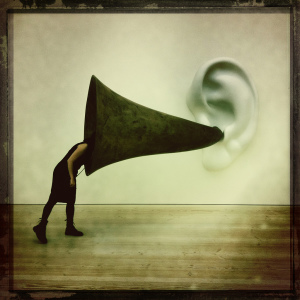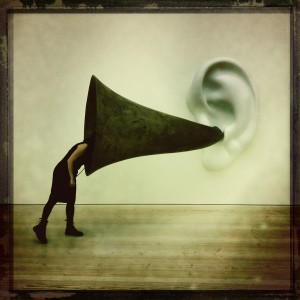
“Listening” online can be similar and yet very different from audible conversations. For years, we have been told that we need to listen twice as much as we talk since God gave us two ears and only one mouth. I have trained many consultants in the art of listening with their ears and eyes. Non-verbal communication is generally an even more telling indicator of emotion. That is why face-to-face communication is generally more productive than any other kind.
 But we live at a time where 50 percent to 75 percent — to maybe even in the 90-percent range — of all communication is done digitally. Let me show you what my typical digital media day looks like. On average, I…
But we live at a time where 50 percent to 75 percent — to maybe even in the 90-percent range — of all communication is done digitally. Let me show you what my typical digital media day looks like. On average, I…
1) Receive 75 to 100 e-mails daily (and generate about that same amount)
2) Initiate or respond to between 50 and 75 interactions daily on an application our team uses called Slack (thanks to Michael Hyatt) to communicate with each other instantly
3) Post, Tweet, Like and communicate on social media an average of 20 to 30 times a day
4) Text 10 to 20 times a day
5) Post a blog that is sent to about 10,000 churches weekly
6) Send 15 t0 20 responses a day through a tool called User Voice which our software team uses to communicate with clients customer service questions
7) Have 2 to 4 telephone conversations a day (including Skype, GO TO MEETING and other video conferencing)
8) Attend 2 to 3 face-to-face meetings a week … unless I am on site with a client, at which time those meetings may last 8 hours.
Given the above, I think it is fair to say that a minimum of 80 percent of my weekly communication is done virtually — or digitally. So, honing my non-audible communication skills and techniques is pretty important.
I am sure that if you evaluated your daily and weekly communication iterations, you would also find that at least 50 percent, if not more, is done from a keyboard of some sort. I do not shy way from phone calls or face-to-face meetings; I still seek them and, as stated above, believe that they are necessary and critical to a dialogue.
However, with the maturation of technology and the pace at which so many of us work, communicate and do life, face-to-face and even telephone conversations are not always practical. In addition, technology has broadened our “reach” and offers the ability to impact a wider audience nationally and globally. For example, we have clients all across the country and some in two other continents. It would not be practical or cost-effective to communicate with each one of them in person, or even on a telephone call given the time zone constraints.
So what is one to do?
Here are 6 lessons I have learned (and am still learning and refining — I have a long way to go) that have helped me with digital and non-audible communication:
1) Read … don’t scan. When your team, clients and others send you a deliberate digital communication, you must take the time to actually read it and not just skim it like you would a blog post (like this one). Read the words. All the words.
2) English 101. I am the greatest of sinners with this one. I get going too fast and am prone to making grammatical errors. (In fact, I just had to correct one in this sentence — DANG, Tim.) This is embarrassing and can erode your capital with the people with whom you are communicating. Let me go on record here that I am so thankful to my readers for overlooking my typos and poor use of the English language over the years. I am trying to be more intentional!
3) Don’t SCREAM. When you are having a verbal, face-to-face meeting, do you like it when people yell at you or get up in your face? Probably not. Well, then don’t use digital YELLING. It is one thing to use capitals or underlines for emphasis — I am cool with that. But do not capitalize an entire sentence or paragraph. I do not like to be yelled at, and I will shut you down in a heartbeat if you use this tactic to make a point.
4) Give the author the benefit of the doubt. Don’t read too much into things. I recall a time when a team member sent an e-mail to a subordinate asking to have a document “re-sent,” but forgot the dash and instead wrote “resent.” Can you image the uproar this caused? Give the other person the benefit of the doubt, and follow the next step: asking follow-up questions.
5) Ask questions. Did something seem odd or not clear? Did the tone rub you wrong for some reason? (Which actually may be due to your lens and not the writer) Ask clarifying questions. Seek to understand.
6) Respond. My biggest pet peeve is when people do not respond to digital communication. If I send you an e-mail or digital communique, assume I am standing right in front of you. Would you think it appropriate to not respond to my verbal in-person question? I believe most of us would agree that if you are sitting across a table from someone, and a comment is made or a question asked, that it is rude to not respond. BINGO! Same applies in the digital world.
So … can you hear me know?
 Tim Cool is project executive at Visioneering Studios in Charlotte, NC, and founder of Cool Solutions Group. Since 1986, Cool has served the church community in the areas of construction, facility planning and facility management. He can be reached at tcool@visioneeringstudios.com. This blog originally appeared on his blog, “Cool Conversations Live.”
Tim Cool is project executive at Visioneering Studios in Charlotte, NC, and founder of Cool Solutions Group. Since 1986, Cool has served the church community in the areas of construction, facility planning and facility management. He can be reached at tcool@visioneeringstudios.com. This blog originally appeared on his blog, “Cool Conversations Live.”


